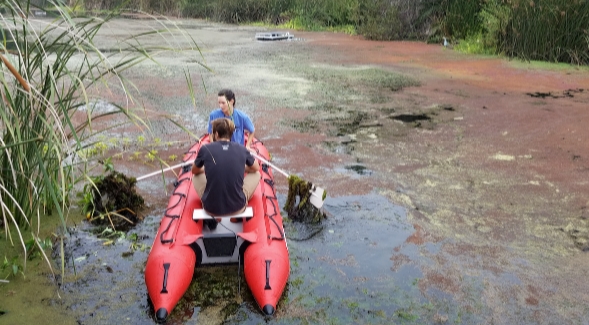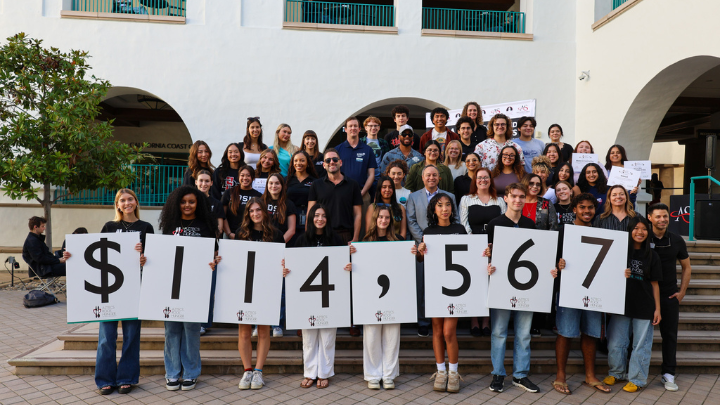Navigating the San Diego River's Past and its Future
Once the lifeblood of the local Kumeyaay people, urbanization has transformed the San Diego River. SDSU researchers are helping to address the problems that ensued.

Before California became a state, Pat Curo’s ancestors lived in the Kumeyaay village of Nipaquay on land that is now home to SDSU Mission Valley — including Snapdragon Stadium and what will soon become a dedicated and revitalized River Park for the greater San Diego community.
“My family came from the people that lived along the San Diego River, from Cuyamaca all the way to Mission Bay,” said Curo, a tribal member of the Barona Band of Mission Indians. The 52-mile waterway provided the Kumeyaay with ample food on a seasonal cycle. “In the fall you’d go to the mountains to pick acorns and in the spring, you’d go to where different plants were harvested.”
The Kumeyaay controlled the flow of the river, creating wetlands. They transplanted oak trees from the mountains to the lowlands to provide a steady supply of acorns.
“Living in Mission Valley, it was an ideal place; they were just four or five miles from the tidepools. They would fill up with fish every low tide, and they had plenty to eat,” said Curo.
Leaving Mission Valley
In 1848, the Gold Rush came to California, followed by statehood in 1850. It became increasingly difficult for the Kumeyaay to make a living in Mission Valley. In 1853, they received permission from a federal Indian agent to relocate 30 miles upriver to the valley of El Capitan Grande, which was designated as a reservation in 1875.
But the population of San Diego — and its thirst for water — continued to grow. During the Great Depression, the city received permission from Congress to build a dam and create El Capitan Reservoir, flooding the valley where Curo’s family lived. The Kumeyaay were ordered to leave.
In 1932, Curo’s family and some other members of the El Capitan Grande Band purchased the Barona Ranch to the northwest of the reservoir and formed the Barona Band of Mission Indians near Lakeside. Another group of families purchased land to the southeast of the reservoir and formed the Viejas Band of Kumeyaay Indians near Alpine. In recent times, several of Curo’s family members have attended San Diego State University.
The reservoir further transformed the San Diego River, which likely formed around 20,000 years ago when sea levels dropped during the Pleistocene.
“They built El Capitan Reservoir in the river itself,” said retired SDSU geologist Eleanora Robbins. “They locked the water into the reservoir so that that water doesn’t come down into the river.”
“And so the lower part of the watershed that we see flowing is mostly coming from urban areas,” said professor of geography Trent Biggs, who runs the SDSU Watershed Science Lab. In the absence of rainfall,that water comes mainly from urban runoff, including spillover from lawns, and leaky pipes.
Today, the City of San Diego gets most of its water from the Colorado River and Northern California, with only a small fraction coming from reservoirs along the San Diego River watershed.
In Mission Valley, flooding caused the San Diego River to change course several times between the 18th and 20th centuries. It would flow into San Diego Bay for several decades at a time before switching course to Mission Bay — then known as False Bay — and after several more decades, it would change course again.
“So the Army Corps of Engineers channelized the river. Now the river flows to the ocean,” said Robbins.
Public Health Pursuit
According to the Environmental Protection Agency, the San Diego River has long been listed as an impaired water body, but SDSU researchers are working to fix it.
“And one of the reasons to fix it is to protect human health on the coast because the river drains right to the coast,” Biggs said. “And the other is to protect ecosystems, because there are valuable and endangered freshwater systems that depend on the river.”
Biggs’ team installed real-time water quality monitors in the river in Mission Trails Regional Park. They measure oxygen levels — which play a role in algal blooms and the health of riparian organisms — as well as tryptophan, which can indicate high levels of bacteria.
In another study, SDSU environmental engineer Natalie Mladenov and her team found that high levels of bacteria correlate with the presence of caffeine and sucralose, found only in human waste.
“It is most likely the mobilization of sewage from leaky sanitary sewers that produced the most severe contamination at sites we monitored in the San Diego River and its tributary,” said Mladenov. Runoff from homeless encampments most likely played a much smaller role.
Restoring the River
Invasive species also harm the river, according to Tom Zink, program manager for the SDSU Soil Ecology and Restoration Group.
“A lot of flooding is caused by the invasive species that come in that really just pack it and the water can’t get through it. So it slows the velocity down and overflows the banks and goes onto the streets.”
Zink’s team removes invasives like palm trees, giant reed and castor bean. Then they replant species that are normally found in the river. These plants act as filters for the water.
“Cleaning the river up basically gets it in a position where it can clean itself up,” Zink said. The result is improved habitat for local wildlife and a pleasant place for people to visit. “It’s a relief, you might say, from living in the city.”
At SDSU Mission Valley, work has now begun on the 34-acre River Park that will be open to all. The design of the park emphasizes the restoration of native plants and flood prevention. And the San Diego River Park Foundation aims to create a continuous trail along the entire 52 miles of the river from the mountains to the sea.
“I think the river is so important for human lives,” said professor of public health Eunha Hoh. “Humans are part of this ecosystem.”



